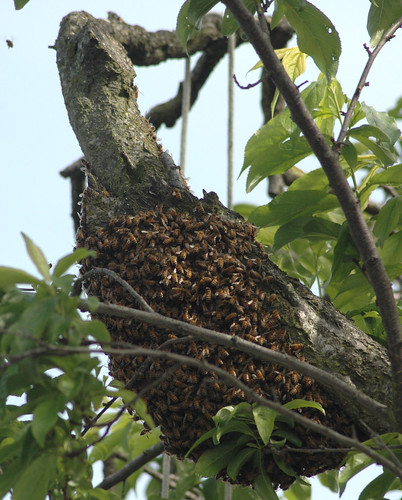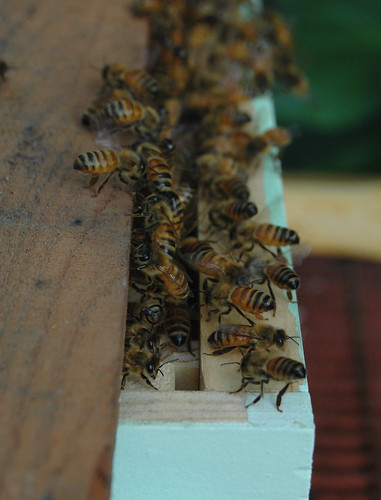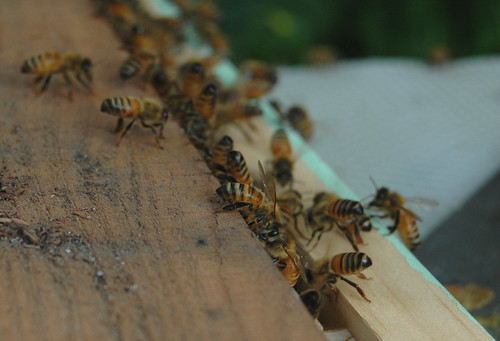Backyard Swarm
...

Due to a combination of lingering headcolds and crappy weather, our backyard apiary has been somewhat neglected this spring. We had managed to split one of our hives this past weekend, and another colony had already produced a swarm. Despite having done some much-needed work, we still haveto get into the rest of our other hives, to do some reconnoitering.
So, I wasn't entirely surprised when Robb called me this afternoon to tell me that he had noticed a swarm of bees in our plum tree. The bees were spread along a branch, about twelve feet off the ground. They probably emanated from our Magnolia hive, which Robb had noticed buzzing furiously earlier in the day.
When I got home from work, Robb and I rigged up some fancy contraptions, made up of bamboo poles, a five gallon bucket mounted on the end of a roller pole, and an oversized paint brush. Bravely armed, and clad in our bee suits, we set to work.
When catching swarms of bees, the objective is to capture the queen. One you've got her, all the rest of the bees are supposed to follow right behind.
With a paint brush taped onto the end of a comically long bamboo pole, we coaxed (and whacked) the bees into our bucket-on-a-stick. As soon as we caught a glob of bees, we dumped them into a waiting hive-box. Manipulating the bucket at the end of a six foot pole took some finesse. Sometimes we were graceful, and sometimes we were just thwacking a tree full of bees.

At some point, the bees in the hive-box started fanning their scent glands, to signal that the queen was at home. We poked around inside the hive-box a tiny bit, but did not see the queen. I prefer to pester the bees as little as possible, when I'm trying to house a swarm. I want them to feel comfortable in their new abode. I have the idea that if I keep fussing with them, they'll get annoyed and move on.

Butts in the air signal that everyone should come on home.

To further entice the bees to stay, I removed a frame of capped honey (and a tiny bit of capped worker brood) from the Magnolia hive, and gave it to this colony. The bees took to this immediately. As I'm writing this, all of our bees have "gone to bed" for the night. Everyone is safely ensconced in their hives, including this new swarm. Hopefully, they'll stick around.
Since we found the bees in our (putative) Santa Rosa plum tree, we'll call this group the Santa Rosa hive. We find it very helpful to have names for the various colonies. These bees are going to go live at a neighbor's house. She'll get a beehive, I'll do the beekeeping work, and we'll split the honey. A nice arrangement for everyone!
If any local blog readers are interested in getting bees, do let me know. I've got plenty to share!

Due to a combination of lingering headcolds and crappy weather, our backyard apiary has been somewhat neglected this spring. We had managed to split one of our hives this past weekend, and another colony had already produced a swarm. Despite having done some much-needed work, we still haveto get into the rest of our other hives, to do some reconnoitering.
So, I wasn't entirely surprised when Robb called me this afternoon to tell me that he had noticed a swarm of bees in our plum tree. The bees were spread along a branch, about twelve feet off the ground. They probably emanated from our Magnolia hive, which Robb had noticed buzzing furiously earlier in the day.
When I got home from work, Robb and I rigged up some fancy contraptions, made up of bamboo poles, a five gallon bucket mounted on the end of a roller pole, and an oversized paint brush. Bravely armed, and clad in our bee suits, we set to work.
When catching swarms of bees, the objective is to capture the queen. One you've got her, all the rest of the bees are supposed to follow right behind.
With a paint brush taped onto the end of a comically long bamboo pole, we coaxed (and whacked) the bees into our bucket-on-a-stick. As soon as we caught a glob of bees, we dumped them into a waiting hive-box. Manipulating the bucket at the end of a six foot pole took some finesse. Sometimes we were graceful, and sometimes we were just thwacking a tree full of bees.

At some point, the bees in the hive-box started fanning their scent glands, to signal that the queen was at home. We poked around inside the hive-box a tiny bit, but did not see the queen. I prefer to pester the bees as little as possible, when I'm trying to house a swarm. I want them to feel comfortable in their new abode. I have the idea that if I keep fussing with them, they'll get annoyed and move on.

Butts in the air signal that everyone should come on home.

To further entice the bees to stay, I removed a frame of capped honey (and a tiny bit of capped worker brood) from the Magnolia hive, and gave it to this colony. The bees took to this immediately. As I'm writing this, all of our bees have "gone to bed" for the night. Everyone is safely ensconced in their hives, including this new swarm. Hopefully, they'll stick around.
Since we found the bees in our (putative) Santa Rosa plum tree, we'll call this group the Santa Rosa hive. We find it very helpful to have names for the various colonies. These bees are going to go live at a neighbor's house. She'll get a beehive, I'll do the beekeeping work, and we'll split the honey. A nice arrangement for everyone!
If any local blog readers are interested in getting bees, do let me know. I've got plenty to share!

Comments
Annalisa
I hope your head colds go away!
BTW: read about you recently in the Rep. flyer about Red. Your paintings worked perfectly with the lighting to convey the content.
(Katrina, from yarn wranglers)